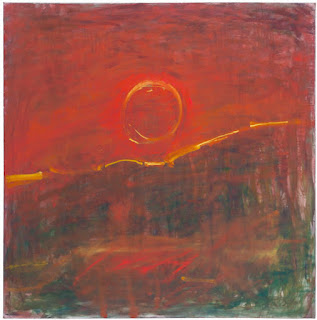 |
| Alice Cahana |
I discovered the Fritz Ascher Society by accident, when I was researching a blog on the artist Alice Cahana. Cahana (1929-2017) was a Hungarian Jew from Sarvar who survived four different concentration camps in the last year of WWII, losing every member of her extended family except her father and her beloved older sister Edith. Edith survived only to perish from illness immediately after liberation. She entered a hospital and Alice never saw her again. Cahana married and came to the US, where she became known for her art of the Holocaust and left a remarkable legacy. Loss is an enduring pain, Nazi terror knew no bounds, and it informed Alice's life and her art. How could it not?
In learning about Alice Cahana, I became interested in the art and the artists who survived the inhuman violence of Nazi Germany and the Holocaust.
 |
 |
| Ascher's Sunset, at Grey's Gallery, in 2019,NYU's fine arts gallery in Washington Sq.in Greenwich Village. |
His work lay hidden from public view until Rachel Cohen discovered his paintings and vowed to bring them to light. “The intensity, the strong energy, the colors, the forms,” she said, recalling the first time she saw his work in the mid-80s. "It was love at first sight." After years of study and research, Cohen is finally bringing Ascher's work to the public, and galleries, art auctions, social media sites, public exhibits, and some media exposure is amplifying the Ascher Society's efforts. Cohen's labor of love is expanding our art universe.
The Ascher Society recognizes as well that while the Nazi terror regime "is certainly the blueprint for authoritarian terror," there are other dictatorial regimes that have suppressed individual and artistic freedom during the 20th century. They deserve recognition too. There was the Stalinist terror of the late 1920s through the 1950s; China's long march terror under Mao ZeDong; Pol Pot in Cambodia; Salazar in Portugal; Franco in Spain, authoritarian takeovers in the Middle East, and in fact up to this 2022 International Holocaust Remembrance Day.
The Ascher Society commemorates those who withstood these powers. I believe with the Ascher Society that by showing their work "we can inspire reflection, creativity and resilience in the face of adversity today...and provide today's audiences and society at large with valuable examples of how humanity can overcome the powers of darkness."
Sources:
1. https://fritzaschersociety.org/ "Comparing Ascher’s self-portraits from before and after the War equally proves instructive and offers insight into how Ascher’s psyche and his self-conception evolved as a consequence of his persecution. For an artist, the self remains a compositional subject infinitely in play as something to explore, avoid, grapple with, or deny. In this regard, Ascher’s multi-medium and multi-faceted study of himself and the representation of the inner life prove to be a consistent thread throughout his career."
2. https://en.wikipedia.org/wiki/Fritz_Ascher
3. https://francurrocaryblog.blogspot.com/2020/12/alice-lok-cahana-holocaust-survivor.html
4. https://borislurieart.org/about-boris-lurie
5. https://www.artforum.com/spotlight/boris-lurie-art-foundation-83595
6. https://300magazine.com/nightmare-art-inspired-by-war-first-us-exhibition-of-fritz-ascher-works/.
7. https://www.timesofisrael.com/if-not-for-the-nazis-he-may-have-been-the-next-leonardo/





No comments:
Post a Comment